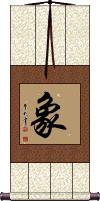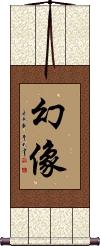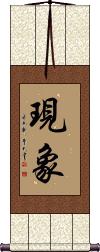Many custom options...
And formats...

Elephant in Chinese / Japanese...
Buy an Elephant calligraphy wall scroll here!
Personalize your custom “Elephant” project by clicking the button next to your favorite “Elephant” title below...
Elephant
象 is the single character that represents an elephant in Chinese, Japanese Kanji, and old Korean Hanja.
Illusion
幻像 is a universal word for Illusion in Chinese, Japanese Kanji, and old Korean Hanja.
The first character means phantasm, vision, dream, illusion, apparition, or fantasy.
The second character means statue, picture, image, figure, portrait, shape, form, appearance, to be like, to resemble, to take after, to seem, or in rare/ancient context: an elephant.
![]() Note that the first character can be written without the left-side radical in Chinese. This form is shown to the right. Both forms are acceptable in Chinese but the character shown to the right is more likely to be read as "elephant."
Note that the first character can be written without the left-side radical in Chinese. This form is shown to the right. Both forms are acceptable in Chinese but the character shown to the right is more likely to be read as "elephant."
See Also: Reality
Phenomenon
I must first say that 現象 is an odd thing to put on a wall scroll in Asian cultures. It won't make a lot of sense alone unless you have a special or personal meaning that you attach to it for yourself.
These two characters mean phenomenon in Chinese, Japanese, and Korean Hanja. They can also be translated as “a happening,” depending on context.
The sum of these characters is a little different than their individual meanings. But I will break it down anyway...
The first character means present, existing, actual, apparent, now, or current.
The second character alone means pattern after, imitate, image, shape, sign (of the times), form, appearance, to be like, to resemble, to take after, to seem, or elephant.
Not the results for elephant that you were looking for?
Below are some entries from our dictionary that may match your elephant search...
| Characters If shown, 2nd row is Simp. Chinese |
Pronunciation Romanization |
Simple Dictionary Definition |
象 see styles |
xiàng xiang4 hsiang zou / zo ぞう |
More info & calligraphy: Elephantelephant (Elephantidae spp.); (surname) Zou gaja; hastin; also nāga; an elephant; v. 像 14. |
龍 龙 see styles |
lóng long2 lung riyou / riyo りよう |
More info & calligraphy: Dragon(out-dated kanji) (1) dragon (esp. a Chinese dragon); (2) naga; semi-divine human-cobra chimera in Hindu and Buddhist mythology; (personal name) Riyou A dragon, dragon-like, imperial; tr. for nāga, which means snake, serpent; also elephant, elephantine, serpent-like, etc., cf. 那. |
釋迦牟尼 释迦牟尼 see styles |
shì jiā móu ní shi4 jia1 mou2 ni2 shih chia mou ni Shakamuni |
More info & calligraphy: Shakyamuni / The Buddha釋迦文 (釋迦文尼); 釋伽文 Śākyamuni, the saint of the Śākya tribe. muni is saint, holy man, sage, ascetic monk; it is: intp. as 仁 benevolent, charitable, kind, also as 寂默 one who dwells in seclusion. After '500 or 550' previous incarnations, Śākyamuni finally attained to the state of Bodhisattva, was born in the Tuṣita heaven, and descended as a white elephant, through her right side, into the womb of the immaculate Māyā, the purest woman on earth; this was on the 8th day of the 4th month; next year on the 8th day of the 2nd month he was born from her right side painlessly as she stood under a tree in the Lumbinī garden. For the subsequent miraculous events v. Eitel. also the 神通遊戲經 (Lalitavistara), the 釋迦如來成道記, etc. Simpler statements say that he was born the son of Śuddhodana, of the kṣatriya caste, ruler of Kapilavastu, and Māyā his wife; that Māyā died seven days later, leaving him to be brought up by her sister Prājapati; that in due course he was married to Yaśodharā who bore him a son, Rāhula; that in search of truth he left home, became an ascetic, severely disciplined himself, and finally at 35 years of age, under a tree, realized that the way of release from the chain of rebirth and death lay not in asceticism but in moral purity; this he explained first in his four dogmas, v. 四諦 and eightfold noble way 八正道, later amplified and developed in many sermons. He founded his community on the basis of poverty, chastity, and insight or meditation, ad it became known as Buddhism, as he became known as Buddha, the enlightened. His death was probably in or near 487 B.C., a few years before that of Confucius in 479. The sacerdotal name of his family is Gautama, said to be the original name of the whole clan, Śākya being that of his branch, v. 瞿, 喬.; his personal name was Siddhārtha, or Sarvārthasiddha, v. 悉. |
魔 see styles |
mó mo2 mo ma ま |
(bound form) evil spirit; devil; (prefix) supernatural; magical (1) demon; devil; evil spirit; evil influence; (suffix noun) (2) (See 覗き魔) -crazed person; -obsessed person; fiend; (can be adjective with の) (3) dreaded; terrible; awful; dreadful; (surname) Ma 魔羅 Māra, killing, destroying; 'the Destroyer, Evil One, Devil' (M.W.); explained by murderer, hinderer, disturber, destroyer; he is a deva 'often represented with a hundred arms and riding on an elephant'. Eitel. He sends his daughters, or assumes monstrous forms, or inspires wicked men, to seduce or frighten the saints. He 'resides with legions of subordinates in the heaven Paranirmita Vaśavartin situated on the top of the Kāmadhātu'. Eitel. Earlier form 磨; also v. 波 Pāpīyān. He is also called 他化自在天. There are various categories of māras, e.g. the skandha-māra, passion-māra, etc. |
三獸 三兽 see styles |
sān shòu san1 shou4 san shou sanshū |
The three animals— hare, horse, elephant— crossing a stream. The śrāvaka is like the hare who crosses by swimming on the surface; the pratyeka-buddha is like the horse who crosses deeper than the hare; the bodhisattva is like the elephant who walks across on the bottom. Also likened to the triyāna. 涅槃經 23, 27. |
五逆 see styles |
wǔ nì wu3 ni4 wu ni gogyaku ごぎゃく |
(1) {Buddh} five cardinal sins (killing one's father, killing one's mother, killing an arhat, shedding the blood of a Buddha, causing a schism within the sangha); (2) (hist) crime of killing one's master, father, grandfather, mother, or grandmother pañcānantarya; 五無間業 The five rebellious acts or deadly sins, parricide, matricide, killing an arhat, shedding the blood of a Buddha, destroying the harmony of the sangha, or fraternity. The above definition is common both to Hīnayāna and Mahāyāna. The lightest of these sins is the first; the heaviest the last. II. Another group is: (1) sacrilege, such as destroying temples, burning sutras, stealing a Buddha's or a monk's things, inducing others to do so, or taking pleasure therein; (2) slander, or abuse of the teaching of śrāvaka s, pratyekabuddhas, or bodhisattvas; (3) ill-treatment or killing of a monk; (4) any one of the five deadly sins given above; (5) denial of the karma consequences of ill deeds, acting or teaching others accordingly, and unceasing evil life. III. There are also five deadly sins, each of which is equal to each of the first set of five: (1) violation of a mother, or a fully ordained nun; (2) killing a bodhisattva in a sangha; (5) destroying a Buddha's stūpa. IV. The five unpardonable sin of Devadatta who (1) destroyed the harmony of the community; (2) injured Śākyamuni with a stone, shedding his blood; (3) induced the king to let loose a rutting elephant to trample down Śākyamuni; (4) killed a nun; (5) put poison on his finger-nails and saluted Śākyamuni intending to destroy him thereby. |
井河 see styles |
jǐng hé jing3 he2 ching ho igawa いがわ |
(surname) Igawa Like the well and the river', indicating the impermanence of life. The 'well ' refers to the legend of the man who running away from a mad elephant fell into a well; the 'river ' to a great tree growing on the river bank yet blown over by the wind. |
伽耶 see styles |
qié yé qie2 ye2 ch`ieh yeh chieh yeh kaya かや |
(female given name) Kaya; (place-name) Gaya (4th-6th century confederacy of chiefdoms in the Nakdong River valley of southern Korea) 伽邪; 伽闍 Gayā. (1) A city of Magadha, Buddhagayā (north-west of present Gaya), near which Śākyamuni became Buddha. (2) Gaja, an elephant. (3) 伽耶山 Gajaśirṣa, Elephant's Head Mountain; two are mentioned, one near "Vulture Peak", one near the Bo-tree. (4) kāya, the body. |
四兵 see styles |
sì bīng si4 bing1 ssu ping shihei |
catur-an.gabalakāya; the four divisions of a cakravarti's troops— elephant, hastikāya; horse, aśvakāya; chariot, rathakāya; and foot, pattikāya. |
大象 see styles |
dà xiàng da4 xiang4 ta hsiang daizou / daizo だいぞう |
elephant; CL:頭|头[tou2] (given name) Daizou large elephant |
小象 see styles |
kozou / kozo こぞう |
young elephant; baby elephant |
巨象 see styles |
kyozou / kyozo きょぞう |
gigantic elephant |
恒河 see styles |
héng hé heng2 he2 heng ho hisaka ひさか |
(personal name) Hisaka 恒水; 恒伽 (竸伽, 殑伽, or 強伽) Gaṅgā, the river Ganges, 'said to drop from the centre of Śiva's ear into the Anavatapta lake' (Eitel), passing through an orifice called variously ox's mouth, lion's mouth, golden elephant's mouth, then round the lake and out to the ocean on the south-east. |
摸象 see styles |
mō xiàng mo1 xiang4 mo hsiang mozō |
to touch an elephant (of proverbial blind people) The blind man who tried to describe an elephant by feeling it, v. Nirvāṇa Sūtra 32. |
普賢 普贤 see styles |
pǔ xián pu3 xian2 p`u hsien pu hsien fugen ふげん |
Samantabhadra, the Buddhist Lord of Truth Samantabhadra (bodhisattva); Universal Compassion; (place-name) Fugen Samantabhadra, Viśvabhadra; cf. 三曼 Universal sagacity, or favour; lord of the 理 or fundamental law, the dhyāna, and the practice of all Buddhas. He and Mañjuśrī are the right- and left-hand assistants of Buddha, representing 理 and 智 respectively. He rides on a white elephant, is the patron of the Lotus Sūtra and its devotees, and has close connection with the Huayan Sūtra. His region is in the east. The esoteric school has its own special representation of him, with emphasis on the sword indicative of 理 as the basis of 智. He has ten vows. |
智象 see styles |
zhì xiàng zhi4 xiang4 chih hsiang chizō |
prajñā, or Wisdom, likened to an elephant, a title of Buddha, famous monks, the Nirvāṇa-sūtra, the Prajñā-pāramitā sūtra, etc. |
有手 see styles |
yǒu shǒu you3 shou3 yu shou aride ありで |
(surname) Aride To have a hand, or hands. hastin, possessing a hand. i. e. a trunk; an elephant. |
狂象 see styles |
kuáng xiàng kuang2 xiang4 k`uang hsiang kuang hsiang kyōshō |
A mad elephant, such is the deluded mind. |
白芋 see styles |
hasuimo はすいも |
(kana only) giant elephant ear (species of taro, Colocasia gigantea) |
白象 see styles |
bái xiàng bai2 xiang4 pai hsiang byakuzou / byakuzo びゃくぞう |
white elephant; (given name) Byakuzou The six-tusked white elephant which bore the Buddha on his descent from the Tuṣita heaven into Maya's womb, through her side. Every Buddha descends in similar fashion. The immaculate path, i. e. the immaculate conception (of Buddha). |
蓮芋 see styles |
hasuimo はすいも |
(kana only) giant elephant ear (species of taro, Colocasia gigantea) |
觀象 观象 see styles |
guān xiàng guan1 xiang4 kuan hsiang kanzō |
Describing an elephant from sight rather than 摸觀, as would a blind man, from feeling it; i.e. immediate and correct knowledge. |
調御 调御 see styles |
diào yù diao4 yu4 tiao yü jōgo |
To tame and control as a master does a wild elephant or horse, or as the Buddha brings the passions of men under control, hence he is termed 調御丈夫 and 調御師 Puruṣa-damya-sārathi. |
象牙 see styles |
xiàng yá xiang4 ya2 hsiang ya zouge / zoge ぞうげ |
ivory; elephant tusk ivory Elephant's tusk, ivory. |
象皮 see styles |
xiàng pí xiang4 pi2 hsiang p`i hsiang pi zō hi |
elephant's skin |
象腋 see styles |
xiàng yè xiang4 ye4 hsiang yeh zōeki |
elephant-body (?) |
象草 see styles |
xiàng cǎo xiang4 cao3 hsiang ts`ao hsiang tsao |
elephant grass; napier grass |
象軍 象军 see styles |
xiàng jun xiang4 jun1 hsiang chün zōgun |
Hastikāya, the elephant corps of an Indian army. |
象馬 象马 see styles |
xiàng mǎ xiang4 ma3 hsiang ma zōme |
elephant and horse |
象駕 象驾 see styles |
xiàng jià xiang4 jia4 hsiang chia zōga |
The elephant chariot, or riding forward, i.e. the eastward progress of Buddhism. |
Click here for more elephant results from our dictionary
The following table may be helpful for those studying Chinese or Japanese...
| Title | Characters | Romaji (Romanized Japanese) | Various forms of Romanized Chinese | |
| Elephant | 象 | zou / zo | xiàng / xiang4 / xiang | hsiang |
| Illusion | 幻像 幻像 / 幻象 | gen zou / genzou / gen zo | huàn xiàng huan4 xiang4 huan xiang huanxiang | huan hsiang huanhsiang |
| Phenomenon | 現象 现象 | genshou / gensho | xiàn xiàng xian4 xiang4 xian xiang xianxiang | hsien hsiang hsienhsiang |
| In some entries above you will see that characters have different versions above and below a line. In these cases, the characters above the line are Traditional Chinese, while the ones below are Simplified Chinese. | ||||
Successful Chinese Character and Japanese Kanji calligraphy searches within the last few hours...






